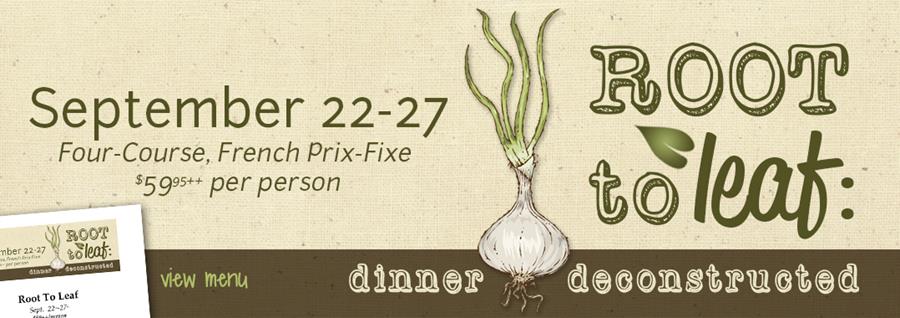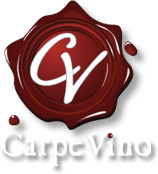
Nothing, Absolute Nothing, is Wasted in “Root to Leaf”
We’ve created more than 40 prix-fixe events since we kicked off the program, and I’ve never seen our normally reserved Chef Alexander more pumped about rolling out a new concept. “Root to Leaf: Dinner Deconstructed” resonates deeply for our Chef because it makes so much sense. Basically, the mantra of a new practice rolling across America is don’t waste anything and exploit elements that are typically overlooked or rejected outright.
Dinner Deconstructed in Chef Alexander’s words: “The theme is that we waste so much food at all levels of the supply chain, and as Americans we need to stop “cherry picking” our cuts of meat or parts of the plant when the whole animal or vegetable is edible and can be made delicious if prepared with care and skill. This movement is growing rapidly and chefs and restaurants are the greatest educators. Remember, whoever heard of braised pork belly 20 years ago before chefs started preparing it? Now it’s as ubiquitous as pork tenderloin. Anyway, I think the idea is not only unique and original but will also be delicious and educational for the customer.”
More about this in a special email tomorrow. Until then, consider joining us this week for Root to Leaf: Diner Deconstructed. Four courses with choices for $59.95 per person ++. Of course, vegetarians will be thrilled with this menu, but protein-less options are available. No split plates or substitutions, please. For reservations, jump on your mobile device and go to www.opentable.com or call the restaurant at 530-308-2698.
First Course (choice of one):
Ricotta Gnocchi Poached In Whey (Heirloom Tomato, Tomato Leaf Pesto, Parmesan Rind Cream): The theme of this month’s prix-fixe comes flying out of the blocks with this dish, cleverly repurposing by-products or waste that would typically be collected by Recology. First, you need to know that classically, ricotta (which means “re-cooked” in Italian) is made from the whey produced during cheese making. Chef’s ricotta is made from whole milk, and the by-product whey won’t be wasted.
For this dish, Chef Alexander’s house-made gnocchi is created from a simple combination of ricotta, egg and flower, which he’ll poach in the reserved whey. And in another creative exploitation, Chef will plate on a cheese sauce infused with flavor from Parmesan rinds that have been stockpiled in the kitchen. In this instance, no cheese is left behind. Garnished with heirloom tomatoes and a pesto made from tomato leaves (sourced from Gary’s tomato patch behind the restaurant)
This classic presentation of dumplings wastes nothing and extracts every bit of flavor and substance from elements that are often seen only as fit for the compost pile.
Crispy Pig’s Ear Salad (Watermelon and Pickled Rind, Herbs, Crushed Peanut): Carpe Vino regulars will recall this entry because Chef has featured a version as a regular menu item. It is a perfect selection for this prix fixe because it embraces the theme of little-used cuts or parts that are championed by innovative chefs and common in Asian cuisine.
First, Chef confits the whole ears in pork fat until nice and tender. Then, he’ll slice and dredge in a gluten-free, crunch-inducing coarse rice flour before deep-frying. This will be plated with diced watermelon, pickled watermelon rinds (again, no waste and lots of taste!) tossed with a dressing of diced cilantro, mint, Thai basil, lime juice and fish sauce. Garnished with crushed peanut (omitted upon request).
Heirloom Carrots (Carrot Top Zhoug, Labne, Spiced Carrot Ash): For this dish, Chef has sourced a variety of colors of heirloom carrots—yellow, orange and purple, that he will prepare sous vide—cooked to perfection at low temperature in a plastic bag (with butter, salt and herbs) in an emersion circulator to trap every bit of flavor. The carrots will be peeled and peels reserved. “Carrot top Zhough, a condiment made from fresh herbs, chiles, garlic and Middle Eastern spices and the carrot tops, is cooked in olive oil and pureed and served as the base layer on the plate, followed by the carrots and labne—yogurt that has been drained and thickened. Finally, the dish is garnished with carrot leaves and “carrot ash,” created from the reserved carrot peels that are cooked until dry, blanched and finally charred before being ground with spices. This is the first time the Chef has employed carrot ash, a technique trending among chefs nationally and one that adds impressive flavor in a different form. And it sounds like something that should not be attempted at home!
Second Course (choice of one):
Farmer’s Minestrone (Cranberry Beans, Pasta Trimmings, Wine-Soaked Croutons): This is a classic dish with sustainable twists. Chef is sourcing as many as 10 different vegetables currently available in the harvest-heavy market; these will be chopped and cooked in chicken stock along with cranberry beans and pasta trimmings that have been reserved and frozen in recent weeks. Again, supporting the theme of “nothing wasted,” Chef has saved the trimmings from our regular menu pasta dishes with the aim of featuring them in this minestrone.
Croutons for this dish are redemptive in two ways: Chef is sourcing whole loafs of bread that have been returned to our supplier, Baker & the Cakemaker, from its retail clients. The bread is perfectly edible and delicious, just not same-day fresh. . .a perfect crouton solution. The loafs will be sliced up and quick-soaked in red wine that has been donated from the Carpe Vino wine bar (partial bottles that are eminently serviceable for kitchen use). The croutons are dried, then toasted before serving and floated in the soup.
Radish Greens and Avocado Toast (French Breakfast Radish, Seeded Levain, Vegetable Sprouts): You can feel really good about ordering this dish because it’s about as healthy as you can get—light and flavorful—plus it exploits every bit of the radish plant. Chef Alexander starts with fresh radish greens—spicy and peppery—blanches then purees with butter and avocado. Seeded levain bread, sourced (fresh!) from the Baker & the Cakemaker, will be sliced, toasted, spread with the puree, layered with French breakfast radishes and garnished with house-sprouted vegetable sprouts (mung beans, lentils and buckwheat). Dressed with a drizzle of olive oil and a squeeze of lime juice.
Main Course (choice of one):
Skuna Bay Salmon (Parsnip, Fuji Apple, Mustard Seed, Apple Core Broth): At Carpe Vino, nothing goes into the dumpster, not even apple cores. For this dish, Chef juices apple cores and fresh apples to extract every nuance of flavor, then warms while whisking in butter, Dijon mustard and seasonings. The apple-core broth goes into a shallow bowl to receive skinned, pan-roasted Skuna Bary salmon (sustainably raised in British Columbia) topped with a salad of sliced Fuji apple, parsnips, mustard seeds and herbs. The reserved salmon skins are crisped and used as a garnish.
Muscovy Duck Breast (Roasted Brassicas, Nectarine, Onion-End Soubise): To appreciate this dish, you need to be prepped on two elements: “Soubise” is a French term for white sauce created using onions. In this instance, Chef is reserving onion ends, slow cooking in butter—to harness the sweetness, short of caramelization—then he will puree. “Brassica” is a genus of plants in the mustard family and includes cauliflower, broccoli, Brussels sprouts and cabbage (bet these are all favorites!). Chef will use every bit of the veggies; for example, the cauliflower cores and leaves won’t be tossed away. . .they’ll be roasted and served with the florets.
Muscoy duck breast is cooked perfectly medium rare and sliced for plating on top of onion-end soubise. The roasted brassicas will be arranged on the plate, along with caramelized nectarines served warm. And get this, the pit will be reserved for another dish. . .that’s right, the pit.
Slow-Roasted Beef Cheek (Glazed Beets and Greens, Horseradish Cream, Red Wine Borscht): Beef cheek is one of the most popular dishes to every appear on a Carpe Vino menu. The cool thing about it is beef cheek was underutilized in general until brought into the mainstream by chefs across the country. This plays directly to the theme of Root to Leaf: use everything, waste nothing.
Chef seasons and slow-roasts the beef cheeks with red wine for six hours, until fork-tender. Sourcing beets from Foothill Roots Farm in Meadow Vista, he’ll wilt the greens and glaze the beets in butter. The beef cheeks will be topped with a horseradish and crème fraiche mixture and dill; he’ll create a sauce to pour around—borscht if you will—from beet trimmings, veal stock, veggies and the juice remaining from roasting the beef cheeks. Amazing. . .and no waste!
Dessert Course (choice of one):
Crème Fraiche Cake (Kadota Figs, Toasted Fig Leaf Ice Cream): Chef Courtney McDonald is preparing two desserts to compliment the Roots to Leaf concept. For this dish, she starts by making a light cake enhanced with crème fraiche. Fig leaves are toasted over an open flame and infuse the ice cream base that is then frozen. Served with warmed green Kadota figs.
Noyaux Custard (Stone Fruit Compote, Almond Brittle): “Noyaux is a spirit (alcohol) made in France from the pits of stone fruit. For this dish, Chef Courtney is cracking the pits from the nectarines used in the duck dish and fresh plums and harvesting the kernel inside. These are then toasted and used to infuse the cream for the pot-de-crème like custard with a nutty flavor. Staying on point with the nutty theme, the custard is served with almond brittle; also enjoy a compote made from plums and nectarines.
Cheers,
gary, Drew & The CV Crew

